
Late 19th Century (1859-1915)
Introduction |
First Conceptions (1830-1859) |
Peter Cooper Presidency (1859-1883) |
Edward Cooper Presidency (1884-1904) |
John E. Parsons Presidency (1905-1915) |
Historical Inaccuracies
The first trustees of the Cooper Union were Peter Cooper (President), Edward Cooper (son), Abram S. Hewitt (son-in-law and Secretary), Daniel F. Tiemann (nephew-in-law), John E. Parsons (lawyer), and William G. Hunt (Businessman and Treasurer) - four family members and two close friends. As noted below, Peter Cooper wanted the Cooper Union to be a public/private partnership but couldn't get anyone outside of his immediate circle to participate, even though he put up all of the money for the venture himself. Three of the trustees (Hewitt, Tiemann, and Edward Cooper) became mayors of New York City, Peter Cooper himself had served as an assistant alderman and alderman, and Hunt had run for mayor. Hewitt also served as a U.S. Congressman and Chairman of the Democratic National Party, and Peter was a candidate for President. Nevertheless, within the corrupt politics of the time, the original trustees who had terms as politicians were never treated seriously as such except when they were valued as honest fronts in times of controversy or scandal.Introduction
It wasn't until 1951 that the President of the Cooper Union became a separate employee from the President of the Board of Trustees. The Annual Reports, written by "the Trustees," often refer to Peter Cooper, although President, as a third party. The Reports were official legal documents submitted to the Common Council of New York City as well as to the New York State Legislature, so the author (or authors) treated it as the report of a committee.
First Conceptions (1830-1859)
Selected Chronology
Selected History
Inspiration
Acquisition
However diffused the sources of Peter's general ideas about education, the first inspiration for Cooper Union itself came from a specific individual. In 1830 or 1831 Dr. David Rogers, a fellow member of the Common Council, gave Peter "an account," as Peter wrote, "of the great advantage he had derived from a short course of study in the Politechnique Institute [the Ecole Polytechnique] of Paris. He stated that the consummate ability of the instructors with their perfect appliances for illustration had enabled him to obtain as much valuable information in a few months as he had done in as many years of previous study. What made the deepest inspiration on my mind was the fact as stated by him that he found hundreds of young men from all parts of France living on a bare crust of bread in order to get the benefit of those lectures. I then thought how glad I should have been to have found such an institution in the City of New York when I was myself an apprentice at a mechanical trade. I then determined to do what I could to secure to the youth of my native city and country the benefits of such an institution ... and throw its doors open at night so that the boys and girls of this city, who had no better opportunity than I had to enjoy means of information, would be enabled to improve and better their conditions, fitting them for all the various and useful purposes of life."
Initial Announcement
In the nearly two decades between his fiftieth birthday and the opening of Cooper Union, Peter Cooper had only one real aim: to get enough money to build his long-planned institution. As he said many years later, he desired to "carry it out as soon as I thought I had the means to accomplish it, if I was compelled to live on bread and water for the remainder of my life." Peter did not have to live on bread and water. In 1855 Beach, who had not mentioned Cooper in his first edition in 1842, now included him among the millionaires. By his own estimate he had increased the $383,500 he was worth in 1846 to $1,106,000 in 1856, exclusive of what he called "paper" and the Cooper Union property, carried at $500,000.
In November, 1852, the Times was able to announce not only Cooper's appropriation of $300,000 for the enterprise and the tearing down of old buildings on the site, but many of the details then planned for the institution. The top would be an observatory "with choice astronomical and microscopic apparatus"; the halls would be opened free for anniversaries, commencements, and the like; the laws for the government of the institution would be made by the students themselves, and "expulsions will be made only by a majority vote of this whole body"; rooms would be set aside for "ladies" who might want to meet to study practical or natural science, and a sum of $500 was to be appropriated each year for the female who exhibited the greatest heroism or endured the greatest sacrifice for suffering humanity; the trustees were to be a judge of the United States Court, three judges of the Superior Court, the mayor, the oldest member of the Cooper family, the president of the Free Academy (the future College of the City of New York), the president of the Mechanics Society, and the editors of the city's principal dailies and weeklies. The third floor would be an "Exhibition Room" with alcoves for statues; the fifth floor would be a lecture room and library; five rooms on the fifth floor on the Third Avenue side would be rented to artists; near one lecture room would be a room for physical experiments and instruments; there was to be a refectory on the Third Avenue side.Mack, Edward C. Peter Cooper, Citizen of New York. New York, Duell, Sloan and Pearce, 1949, pp. 131-2, 183, 244-45
Original Ideas and Modifications
Peter Cooper's original ideas for his institute had been very naive and impractical in most details, and as late as 1856 had been the despair of his son and [son-in-law]. They were based on his own experience as a young mechanic. In his youth ambitious young men had worked such long hours that they could not pursue regular courses of instruction even had any been offered; and in his first plans he thought little of such courses. They should be given, but should hold a subordinate place. He himself had profited greatly as a lad from the famous collection of curiosities called Scudder's Museum, later succeeded by Barnum's Museum. Its waxworks, stuffed animals, historical relics, and mechanical devices had stimulated his mind and awakened his imagination. At first, therefore, he wanted a large museum in his Union. On the upper floor of Scudder's Museum had also been a cosmorama: a collection of pictures of foreign scenes, historical events, and eminent personages, brilliantly illuminated and surveyed through peepholes. This likewise had once delighted him, and he wished a similar cosmorama in his Union. Since in early manhood he had listened eagerly to lectures, and the fifties were the heyday of the lyceum, he planned a large lecture-room. He had always learned much, in Yankee fashion, from conversation and debate with practical men as keen as himself. He therefore believed that his Union should contain a number of rooms where young men of the same pursuits or trades could meet regularly and engage in free discussion.
The building of the Union embodied all his original ideas, good and bad. The great lecture hall was on the basement floor. The two first floors above were to be occupied by stores and offices, whose annual rent would pay the operating expenses of the Union. On the third floor was a spacious room intended for the museum; while on the story above was another large room to contain the cosmorama. A large portion of the remainder of the building was divided into small meeting-rooms for the "discussion groups" or informal debating societies. The broad flat roof was to be enclosed with a balustrade and converted into a roof garden, where on warm days or evenings crowds of people might listen to music from a band and buy inexpensive refreshments.
But as the building was completed, and as definite and detailed plans were first made for its use, Peter Cooper's advisers had persuaded him to modify and enlarge his ideas. The proposed museum gave way to a great free reading room. The room designed for the cosmorama became a laboratory; the discussion rooms for the various trades became classrooms; the roof was left unused. Systematic courses of instruction by expert teachers were made the principal care and labor of the institution, and its organization was based on well-drilled classes. If Peter Cooper sometimes showed reluctance, he was won over to these changes by the proof that they worked and that they pleased the groups he meant to reach. Once, years later, as he looked over the area on the roof where he had once pictured happy crowds under the spell of a fine orchestra, [he exclaimed] wistfully, "Sometimes I think my first plan was the best!" But for the most part he agreed cordially that the later plans were the wiser.Nevins, Allan. Abram S. Hewitt: with some account of Peter Cooper. New York, Harper, 1935, pp. 177-8
In addition to the public/private partnership originally envisioned by Peter Cooper to run the Union (see above), an offer (for political purposes) was made to the NYC Board of Education, consideration was given to the General Society of Mechanics and Tradesmen (but the Society's charter limited benefits to apprentices of mechanics and tradesmen), and a provision in the Charter would have allowed for Columbia College to take it over or merge with it (approached prior to opening and rejected by Charles King, and again in 1868 under Frederick Barnard, rejected in 1869).
Influences on Peter Cooper and Antecedents to the Cooper Union
Historical Significance
By 1859 the conception of a free education in science, art, and politics for the common man was no longer a novelty. Yet there was nothing like Cooper Union in New York in 1859. Adult education was non-existent except for lyceums, mechanics' institutes, the evening classes inaugurated in 1848 by Peter's Public School Society, and an occasional labor college, like the Albany Manual Labor University. Moreover, if Cooper's ideas were not original, they were part of the best and most advanced thinking of his time and were shared only by those at the forefront of intellectual development. The very willingness to donate so large a fortune to the public good while he was still alive was itself almost unique. Astor and Girard gave money only after death, and other comparable gifts, like those of William Corcoran, George Peabody, and Matthew Vassar were made after Cooper Union was founded. Moreover, Cooper was, along with Horace Mann, one of the first in the nineteenth century to assert that wealth was a trust, a doctrine that he proclaimed loudly on numerous occasions.
Cooper and his union had more followers than antecedents. Peter knew both Matthew Vassar and Ezra Cornell, and influenced both of them; Carnegie has admitted inspiration of Cooper; the engineer Edwin A. Stevens, a friend of Hewitts', profited by the latter's advice in setting up his Stevens Institute for Engineers; Drexel in Philadelphia, Pratt in Brooklyn, and Armour in Chicago got ideas from Cooper Union; above all the fabulously wealthy George Peabody consulted both Hewitt and Cooper when he was setting up his Peabody Institute.
Peter Cooper was the exact opposite of most rich men, who give money for an institution to be erected after they are dead. He conceived the idea when young, helped bring it to detailed realization, and then had the good fortune to live a quarter of a century to watch over it. During that quarter of a century he was seldom absent from it a day. Constantin Herzberg remembers Peter at the Union until nine in those early days, showing classrooms to visitors or seeing if anything was needed. No wonder that the Cooper Union not only reflected the specific ideas of its founder, but, even more important, was permeated with his influence. Cooper Union was in very literal truth Cooper's Union, and it would have been highly inappropriate had the Legislature not added his name "against his express wish" that it be called simply the "Union."Mack, Edward C. Peter Cooper, Citizen of New York. New York, Duell, Sloan and Pearce, 1949, pp. 247, 250-2
Peter Cooper Presidency (1859-1883)
Selected Chronology during the Peter Cooper Presidency
- 1859, November 2: First scientific lecture given in the Great Hall
- 1859, November 7: First day of classes
- AY 1864: First mention of set of 21 free lectures in social and political science provided in the Great Hall to satisfy Charter requirement
- AY 1864: First "endowment" donations, $1,000 from Frederick A. Lane, $500 from the estate of Robert C. Goodhue, and $100 from Wm. Pitt Palmer, all for the Women's Art School
- 1864, May 25-27: Art Receptions and Commencement Exercises include first 5 graduates who have completed 5-year course of studies in Night School of Science
- 1869, February?: Western Union Telegraph provides instruments and an instructor for the first class of the new Free School of Telegraphy for Women
- 1871, February 12: Peter Cooper pledges, at 80th birthday celebrations, to provide the Cooper Union with a $100,000 endowment
- FY 1872: Peter Cooper puts an additional $7,000 into a special endowment fund, interest to be used for rewarding employees
- FY 1873: The trustees invest Peter Cooper's $100,000 in bonds of Pompton Township, but do not receive the expected $7,000 per year on the investment
- AY 1876: Saturday Program established for 85 NYC and Brooklyn public school teachers to enable them to bring art instruction into their schools
- AY 1877: Women's Centennial Committee provides $1,500 for a fund for indigent female art students
- 1883, April 4: Peter Cooper dies a few weeks before the end of the academic year

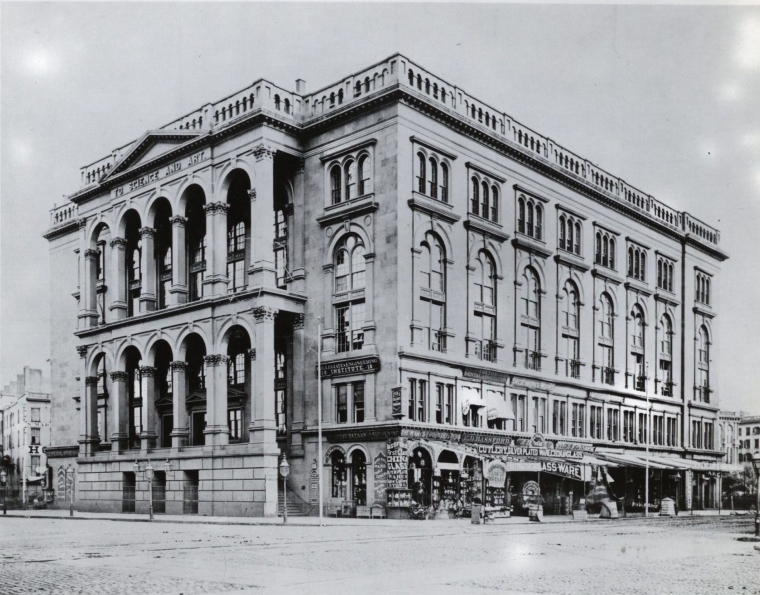
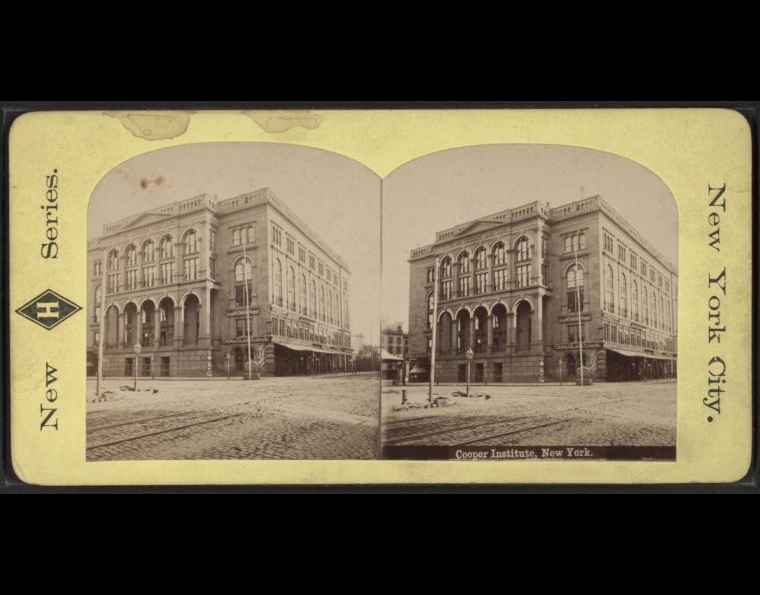
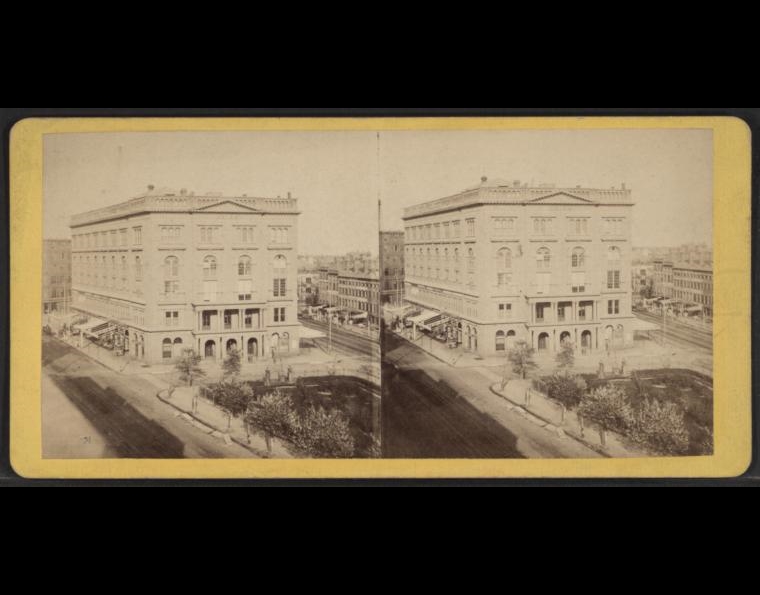
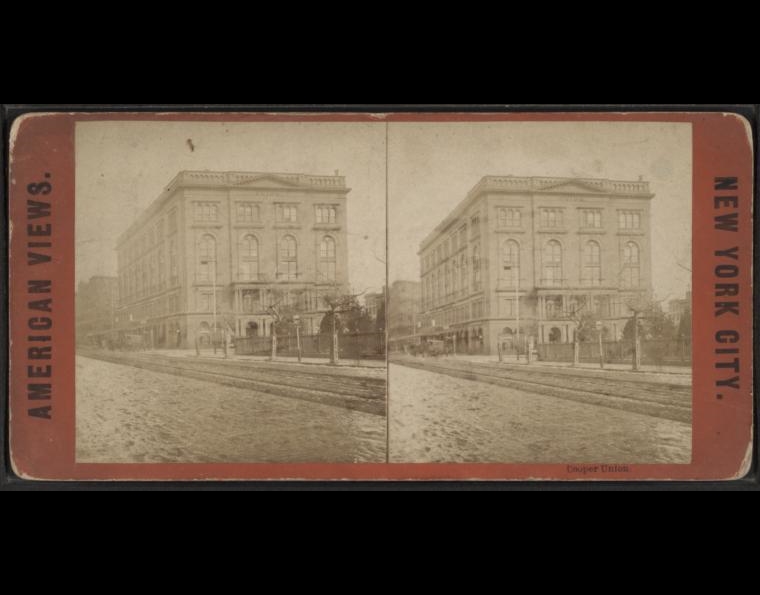
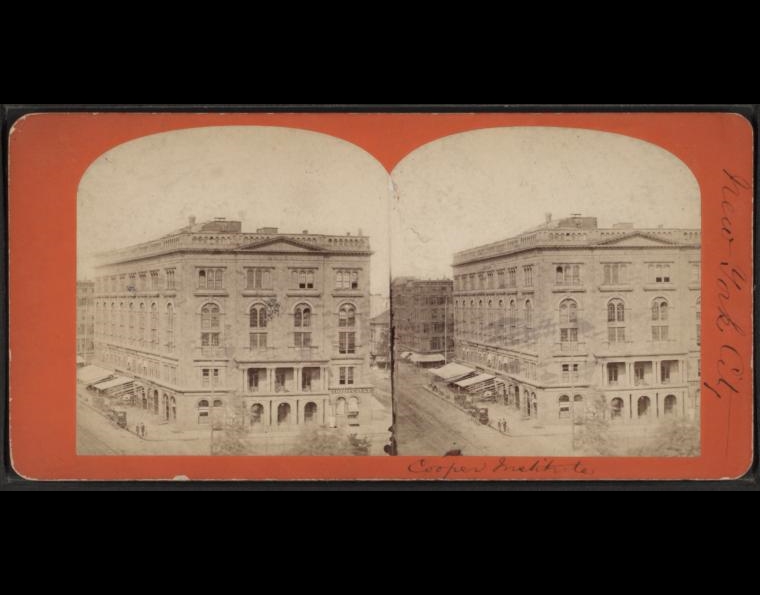
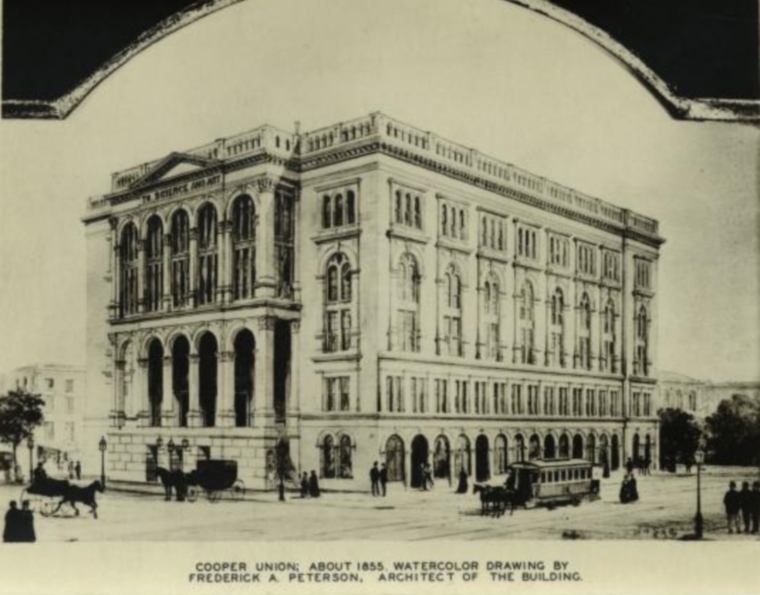
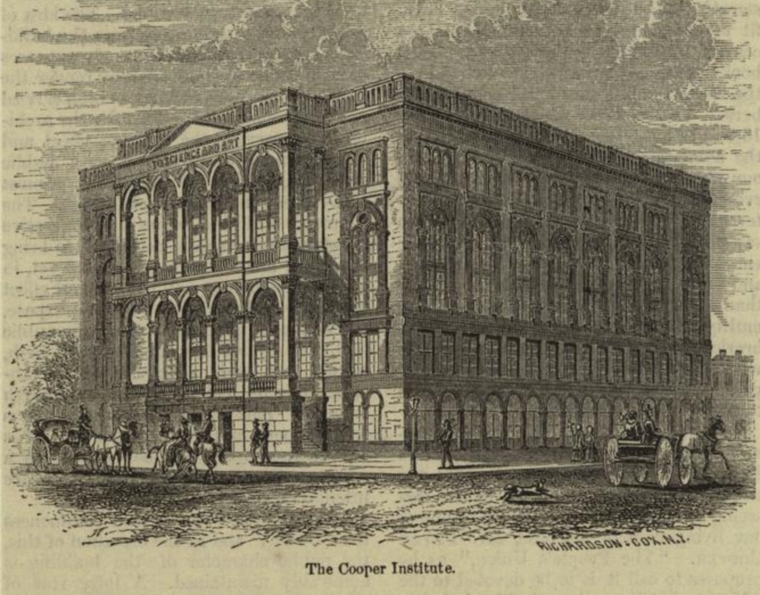
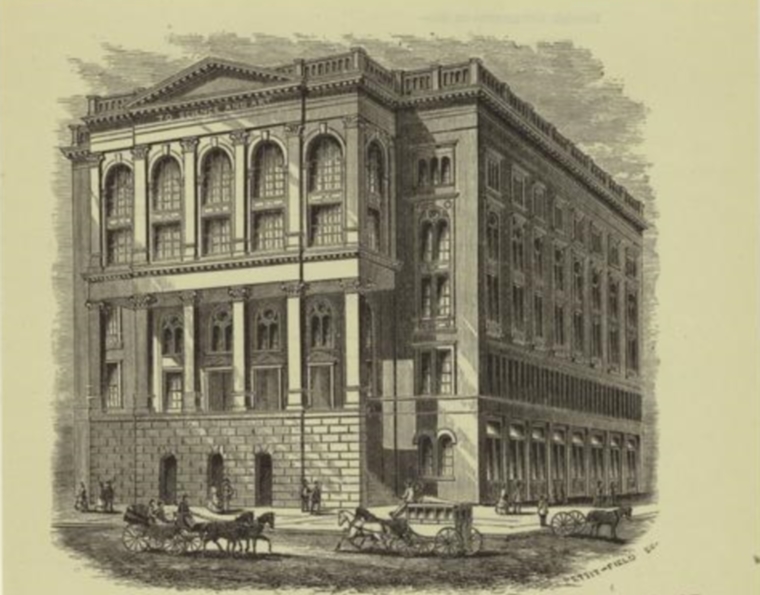
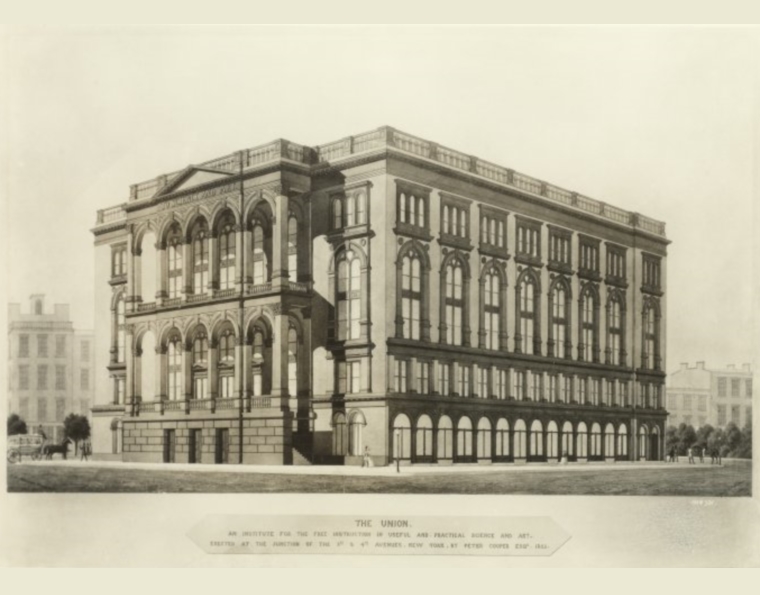
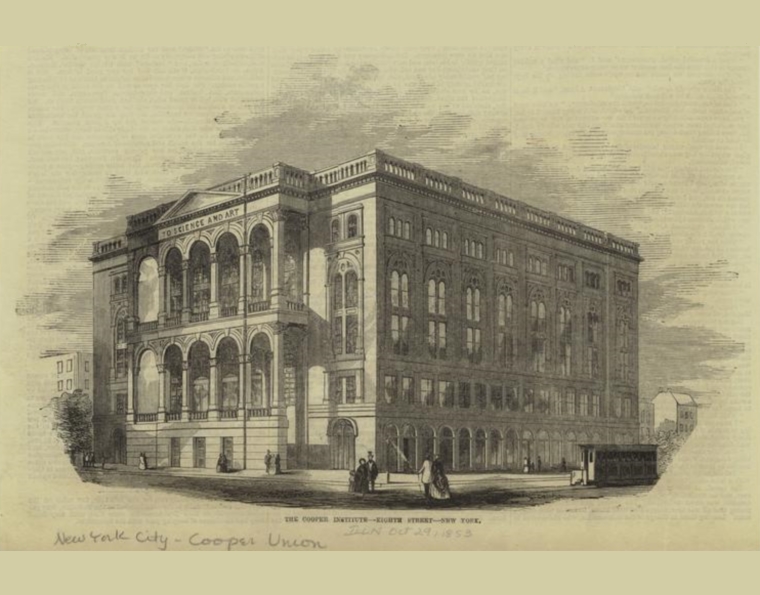
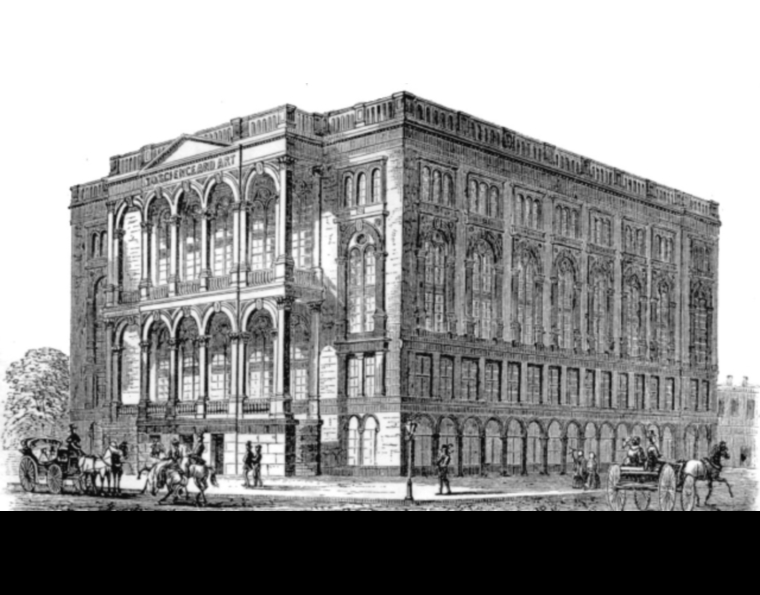
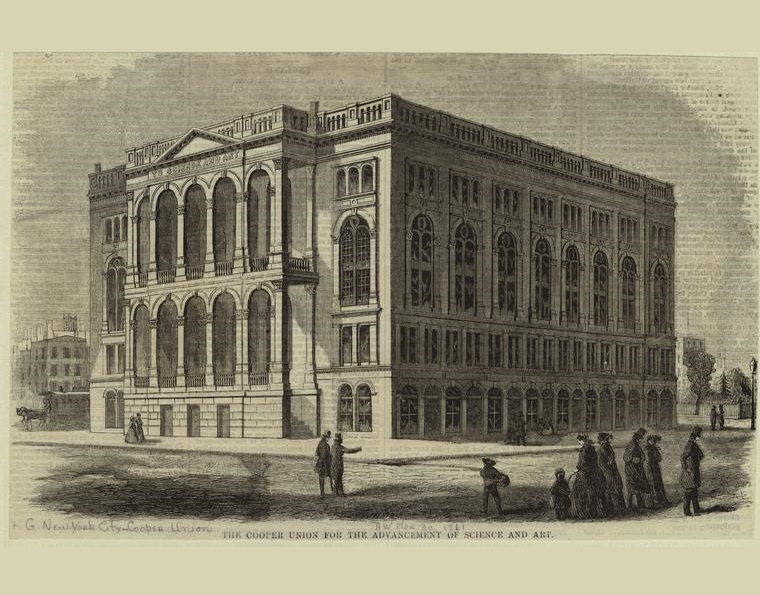
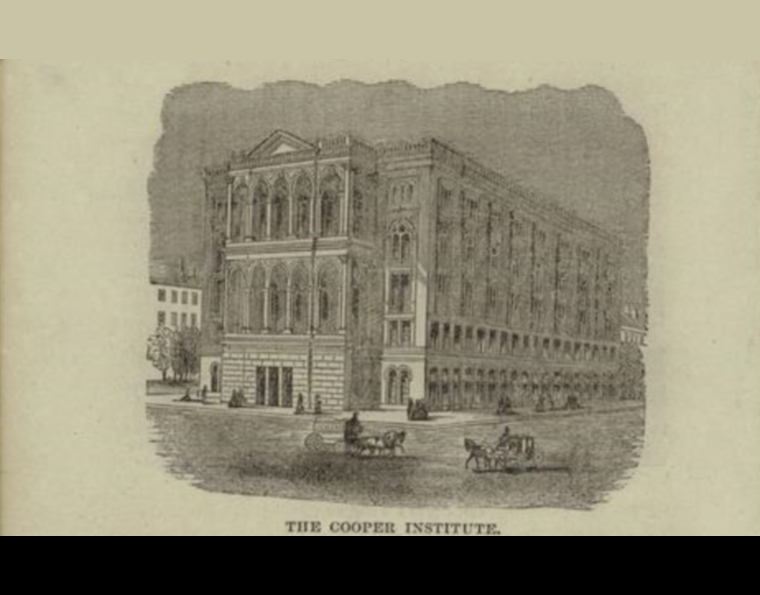
Selected History during the Peter Cooper Presidency
The structure of the Cooper Union was developed during the first five years, between AY 1860 and AY 1864.
Unfortunately, the Annual Reports for AY 1862 and AY 1863 are missing, so the transition from a proposed three-year program to a five-year program is not documented. What is known is that in AY 1860, the Cooper Union opened with three teachers in the School of Design for Women and fifteen teachers of seven classes in the Department of Night Instruction. In AY 1860 there is also the Reading-Room and a Gallery of Art on the third floor, and a Debating Society. In the AY 1861 Annual Report, the Gallery of Art is called the Picture Gallery, and the Department of Night Instruction is referred to as the Polytechnic School. By AY 1864, free Lectures are provided at night, and the Free Night School of Science and Art provides the same classes as in AY 1860, except that there are three more classes. This is the same year that the Cooper Union sees its first graduates, 5 students who are given medals for completing a five-year course of studies. The Annual Reports, instead of being published on January 1, are published on July 1, and later, at the end of May. The year of the first graduation includes also the first mention of the Exhibition, the equivalent of the End of Year Show. The annual Exhibition becomes so prestigious that in AY 1876, at the Centennial Exposition, the Cooper Union is asked to participate.Although the Annual Report for AY 1865 is missing, from later reports we know that three more students are given medals in AY 1865. By AY 1866, the system that will persist throughout Peter Cooper's presidency is established: every student who successfully completes a course in either the School of Design for Women or in the Free Night School of Science and Art is given a First Grade Certificate (the Third Grade Certificate is eliminated after AY 1864 and the Second Grade Certificate is paused after AY 1879); those students who complete the full course of studies are given a diploma, and those students who achieve First Grade Certificates in the full course of studies are also given a Medal. In AY 1866, five students receive diplomas and only one of the five receives a medal: Rosalinda H. Palmer, the Cooper Union's first female graduate of the Free Night School of Science.
First, it is important to note that there were no regular courses of studies in the Free Art School for Women or in the Free Night School of Art (for men only), although thousands of students attended these two schools and received First Grade Certificates, as well as prizes and honors, including gold, silver, and bronze medals. Similarly, in the Free Night School of Science, thousands of students received First Grade Certificates, although many did not stay to the end of the school year, and others missed too many classes to earn a First Grade Certificate. Of course, some couldn't commit to a 5-year course of study, and others couldn't handle the more advanced courses. But it seems astonishing to us that many weren't interested in sitting for examinations or weren't interested in pursuing the full course of studies. Peter Cooper's feeling that mechanics and tradesmen wouldn't sit in classes was proved wrong, but the notion of pursuing knowledge for its own sake was also common. That is why the Cooper Union is considered the first to offer "continuing education" rather than the first to offer college degrees for free, which most of its students did not desire.
The choral class, under the guise of a variety of names, including the Orpheon Free Chorister Class, persisted until AY 1869. The Picture Gallery, which was next to the Reading Room, was closed in AY 1866 to provide a space for an Association of graduates and others, although it reappears in AY 1868 and continues to be mentioned in the finances until FY 1870. In AY 1866 the Reading Room is thereafter referred to as the Reading Room and Library, the difference being that periodicals and magazines were obtained under the Reading Room's budget (as well as a host provided for free by their publishers) and books and maps were obtained under the Library's budget (or donated). The free lectures in the Great Hall are formalized into the Free Saturday Lectures for the People in AY 1870.
The Free Day School of Telegraphy for Women is first mentioned in AY 1868. A Free Night School of Telegraphy for Young Men exists for two years, AY 1870 and AY 1871. The classes in "photography" do not involve taking photographs or printing them, but coloring them using photo-crayon and photo-color techniques. The Normal Teacher class is added in AY 1876. As to the Free Night School of Science, some students can choose to study practical chemical analysis and industrial arts in AY 1874. A Consulting Department, for help with inventions, existed from AY 1877 to AY 1879. Finally, in AY 1881, the trustees authorized the Chemical Laboratory to establish a three year course of study, which produces its first graduate in AY 1884.
The number of instructors of the Free Night School of Science and Art varies between 21 and 25, except in AY 1872, when only 17 names are listed. The number of instructors in the Free Art School for Women is harder to discern; it starts at 3 in AY 1860, 4 in AY 1861, and 6 in AY 1864 and AY 1866. From thereon, most Annual Reports only provide the names of the Principal, the Director of the Free School of Women in Wood Engraving, and the teacher in the School of Telegraphy for Women. Although there are glimpses as the teaching staff increases to 10 to 12 between AY 1878 and AY 1883, not including lecturers from the Night School and the English Department, guest lecturers from other art schools, and more advanced students teaching less advanced students.
Abram Hewitt, Secretary, writes the Annual Reports until AY 1871. J.C. Zachos, who gives a Free Saturday Lecture on Shakespeare in AY 1871 and on "Mechanical Progress" in AY 1872, is hired as Curator and Professor of English Language and Literature in AY 1873 and writes his first "Curator's Report" (a Summary Report substitutes for the Annual Report in AY 1872); similarly, Fitz Gerald Tisdall, Jr. Director of the Schools writes his first "Report of the Director" and Susan N. Carter writes her first "Report of the Womens Art School." The first "Report of the Engraving School" is written by Charlotte B. Cogswell in AY 1874 and the first "Report of the Lecture Committee" is written by R. W. Raymond in AY 1878. George W. Plympton, who left the Brooklyn Polytechnic Institute in 1869 to become Professor of Philosophy, Mechanism, and Astronomy, takes over as Director of the Free Night Schools in AY 1880.
In AY 1883, with the death of the Founder, Hewitt returns to write a message on behalf of the trustees, and there are many other tributes along with the reports.
Key Personnel during the Peter Cooper Presidency
- Trustees (AY 1860-1883): Peter Cooper, President; Wilson G. Hunt, Treasurer; Abram S. Hewitt, Secretary; Edward Cooper; Daniel F. Tiemann; John E. Parsons
- Advisory Council of the School of Design for Women
- Full-Term (AY 1860-1883): Mrs. S. L. M. Barlow; Mrs. V. Botta; Mrs. Abram S. Hewitt; Mrs, Wm. H. Osborn; Mrs. John Sherwood; Mrs. Jonathan Sturges
- Early (AY 1860-1861): Mrs. A. M. Cozzens (AY 1860-1861); Mrs. Richard Hildreth (AY 1860-1861); Mrs. Wm. Henry Jones (AY 1860-1861); Mrs. R. Ogden Doremus (AY 1861), Mrs. C. M. Kirkland (AY 1861)
- Other Founding: Miss Mary M. Hamilton (AY 1860-1868); Mrs. Geo. Curtis (AY 1860-1874); Mrs. Henry M. Field (AY 1860-1874)
- AY 1861-1883: Mrs. Robert Gracie; Mrs. Hamilton Fish
- AY 1864-1883: Mrs. C. Carson; Mrs. J. H. Choate; Mrs. C. P. Daly; Mrs. E. H. Miller; Mrs. T. J. Oakley
- AY 1866-1883: Mrs. William T. Blodgett; Mrs. Richard Tighe
- Other: Miss Helen Russell (AY 1861-1868); Mrs. M. O. Roberts (AY 1864-1874); Mrs. Georgiana L. Schuyler (AY 1869-1878)
- Late (AY 1877-1883): Miss Margaret A. Cooper; Miss Amy B. Hewitt; Mrs. Thos. M. Wheeler
- Last (AY 1880-1883): Mrs. Edward Cooper
- Curator: James. T. Hodge (AY 1860); Richard S. Smith (AY 1861); Vincent Colyer (AY 1868-1869); J. C. Zachos (AY 1872-1883)
- Principal, School of Design for Women: Mr. T. Addison Richards (AY 1860); Mrs. Henry M. Field (AY 1861); Mrs. Lucy A. Cuddehy (AY 1864-1866); Wm. Rimmer (AY 1867-1870); Miss Ellen E. Childe (AY 1871-1872); Susan N. Carter (AY 1873-1883)
- Principal, Night School of Science and Art: Joseph G. Fox (AY 1866-1870); Fitz Gerald Tisdall (AY 1871-1879); Geo. W. Plympton (AY 1880-1883)
- Director, Laboratory: Albert Gallatin (AY 1875-1876), Thomas J. Parker (AY 1877-1878), W. Goold Levison (AY 1879-1883)
- Directress, Free Day School of Telegraphy for Women: Lydia (Lizzie) H. Snow (AY 1869-1872); Miss Mary S. Dickinson (AY 1873-1881); Mrs. M. E. Williams (AY 1882-1883)
- Director, Free School for Women in Wood Engraving: Wm. J. Linton (AY 1870); Charlotte B. Cogswell (AY 1871-1880); John P. Davis (AY 1881-1883)
- Manager, Free Night School of Telegraphy for Young Men: A. S. Brown (AY 1870-1871)
- Acting Manager, Lecture Course: R. W. Raymond (AY 1879-1883)
Statistics during the Peter Cooper Presidency
| 1859- 1883 | Night | Day | ||||||
|---|---|---|---|---|---|---|---|---|
| Free Night School of Science (for Men and Women) | Free Night School of Art (for Men) |
Free Night School of Telegraphy for Young Men |
Free Art School for Women | Free School for Women in Engraving | Free School of Telegraphy for Women |
|||
| Year | 1st Class Certificates | Diplomas (5 year) | Medals (1st Class) | 1st Class Certificates | 1st Class Certificates | 1st Class Certificates |
1st Class Certificates | 1st Class Certificates |
| AY 1860 | 61 | not applicable | 141 | not applicable | 67 | not available | not applicable | |
| AY 1861 | not available - AY 1860 Annual Report is dated January 1, 1860, certificates are awarded in June | |||||||
| AY 1862 | not available - AY 1862 Annual Report is missing | |||||||
| AY 1863 | not available - AY 1863 Annual Report is missing | |||||||
| AY 1864 | 91 | not applicable | 5 | 150 | not applicable | 56 | 11 | not applicable |
| AY 1865 | not available | not available | 3 | not available | not available | not available | ||
| AY 1866 | 212 | 5 | 1 | 174 | not available | not available | ||
| AY 1867 | 174 | 8 | 7 | 262 | not available | not available | ||
| AY 1868 | 148 | 5 | 4 | 106 | 69 | 10 | ||
| AY 1869 | 108 | 5 | 5 | 161 | 38 | not available | 8 | |
| AY 1870 | 171 | 6 | 6 | 258 | 13 | 62 | 12 | 31 |
| AY 1871 | 182 | 6 | 5 | 320 | 28 | 68 | 28 | 55 |
| AY 1872 | 261 | 4 | 4 | 303 | not applicable | 56 | 36 | 29 |
| AY 1873 | 278 | 3 | 3 | 289 | 100 | 27 | 9 | |
| AY 1874 | 292 | 4 | 4 | 317 | 98 | 16 | 18 | |
| AY 1875 | 343 | 1 | 1 | 338 | 76 | 20 | 14 | |
| AY 1876 | 348 | 5 | 5 | 293 | 85 | 23 | 15 | |
| AY 1877 | 326 | 6 | 5 | 283 | 177 | 21 | 16 | |
| AY 1878 | 332 | 6 | 6 | 291 | 174 | 25 | 13 | |
| AY 1879 | 356 | 5 | 3 | 278 | 145 | 18 | 18 | |
| AY 1880 | 388 | 2 | 3* | 341 | 160 | 16 | 5 | |
| AY 1881 | 390 | 8 | 8 | 321 | 150 | 5 | 18 | |
| AY 1882 | 346 | 10 | 8 | 322 | 141 | 4 | 28 | |
| AY 1883 | 407 | 3 | 2 | 371 | 160 | 4 | 29 | |
*The unusual situation in AY 1880 (number of medals higher than number of diplomas) is due to two graduates from AY 1879 returning to earn first grade certificates in classes they had taken in earlier years, in order to earn medals.
Note: The number of certificates is not the number of students. For example, students in the Free Night School of Science could take from two to four classes per year (and needed to in order to complete the 5-year course of studies), students in the Free Art School for Women earned First Class Certificates in Drawing, in Painting, and in both (one student earned three First Class Certificates, in Drawing, Painting, and Sculpture). The names of the students earning First Class Certificates is listed in the Annual Reports, but given the hundreds of names, it would take the CUHP enormous effort to crunch down the number of certificates into numbers of pupils. This, also, would not be an accurate reflection of the number of students admitted and the number of students remaining at the end of the year. The attrition rates were very high, as illustrated below. Furthermore, as to the engineering students who stayed to the end of the course and passed their exams and the art students who stayed to the end of the course and whose work was considered worthy of a First Class Certificate, the graduation rates were very low, as illustrated below. The Annual Reports list from 2,000 to 3,000 students admitted, from 1,200 to 1,800 making it to the end of the year, and from 700 to 900 First Class Certificates being awarded, without accounting for students taking more than one class.

These numbers leave out students in the huge Chorus class (400 students) and in the two English Department classes (standing room only, numbering between 100 and 200 students per year in each).
Finances during the Peter Cooper Presidency I
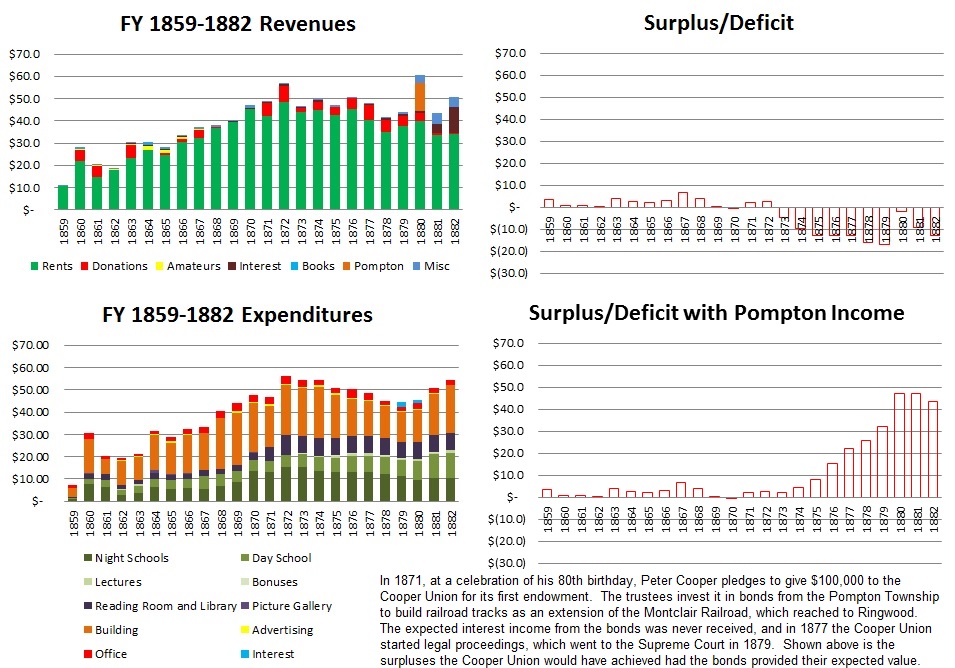
During Peter Cooper's presidency, the fiscal year and the academic year did not align. The treasurer used a January 1 to January 1 fiscal year. This puts the finances out of sync with the academic year and reports: FY 1859 is in the AY 1860 Annual Report, etc.
Over 90% of the Cooper Union's revenues came from rents on the first floor stores, second floor offices, and basement Great Hall and other halls of the Foundation Building. In FY 1869, the Cooper Union signs a 20 year lease with the National Bank Note Company to lease out the top floor and a portion of the floor below for $10,000 per year. The rental income was supplemented by occasional donations, primarily but not exclusively from Peter Cooper. Minor sources of income were payments received from the amateur class between 1860 and 1867, interest income on a $5,000 government bond, and sales of old papers. Between 1860 and 1865, students who wanted to buy their textbooks were sold them at cost; these also appear on the balance sheets.
At a birthday celebration in honor of his 80th birthday, Peter Cooper provided the Cooper Union with its first large endowment, $100,000:
New York, February 12th, 1871.
TO THE TRUSTEES OF THE COOPER UNION FOR THE ADVANCEMENT OF SCIENCE AND ART:
Gentlemen:
Having this day completed my eightieth year, I am admonished of the uncertainty of life, and of the propriety of doing what I can while I have health, to promote the substantial welfare of this Institute. To accomplish this purpose, I have set apart, and hereby give, to the trustees of the Cooper Union, $100,000.
The trustees are hereby requested to keep the said fund securely invested, and to use one-half of the interest arising therefrom for the formation of a reference and lending library, for the use of all classes of working men and mechanics of the city. The other half of the interest arising from this fund may be used for any purpose which the trustees believe will more effectually promote the highest good of this Institution.
I hereby further authorize the trustees of the Cooper Union to draw on me, or, in the event of my death, upon my legal representatives, for the further sum of $50,000, as soon as they can wisely use this amount, in the formation and arrangement of this library.
PETER COOPER.
The trustees invested this money in bonds from the Pompton Township, which planned to conduct surveys and build an extension to the Montclair Railroad. The investment turned out to be a headache that lasted for decades. First, the township did not provide the 7% interest ($7,000) per year, forcing the Cooper Union to take out loans to meet its obligations. Eventually, the Cooper Union tried to get its money back and started legal action in a case that went all the way to the United States Supreme Court, which the Cooper Union lost (see Pompton V. Cooper Union, 101 U.S. 196 (1879)). It wasn't until 1880 that the Cooper Union received its first interest payment from the Pompton bonds, as reflected in the AY 1881 Annual Report and a June 18, 1880, article in The New York Times. The charts above illustrate the deficits that the Cooper Union experienced, and the surpluses it would have seen, because of the bad endowment investment. Curiously, except for some line items in the Treasurer's Reports, neither the Annual Reports or the biographies of Peter Cooper or Abram Hewitt mention the fiasco. The saga is further reported in a June 6, 1884, article in The New York Times, which documents further legal proceedings that went to the New Jersey Supreme Court (which Cooper won).

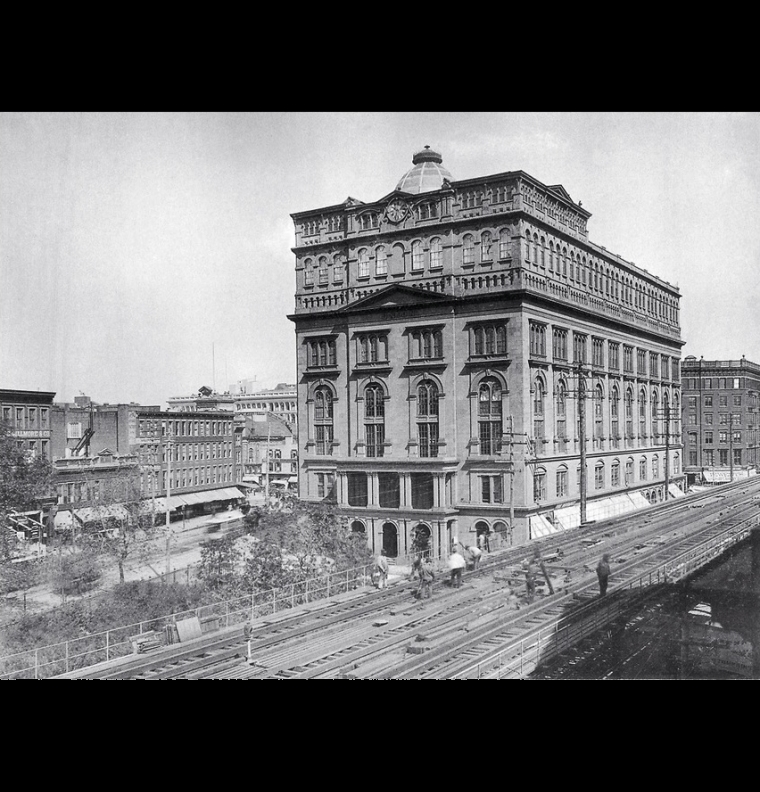
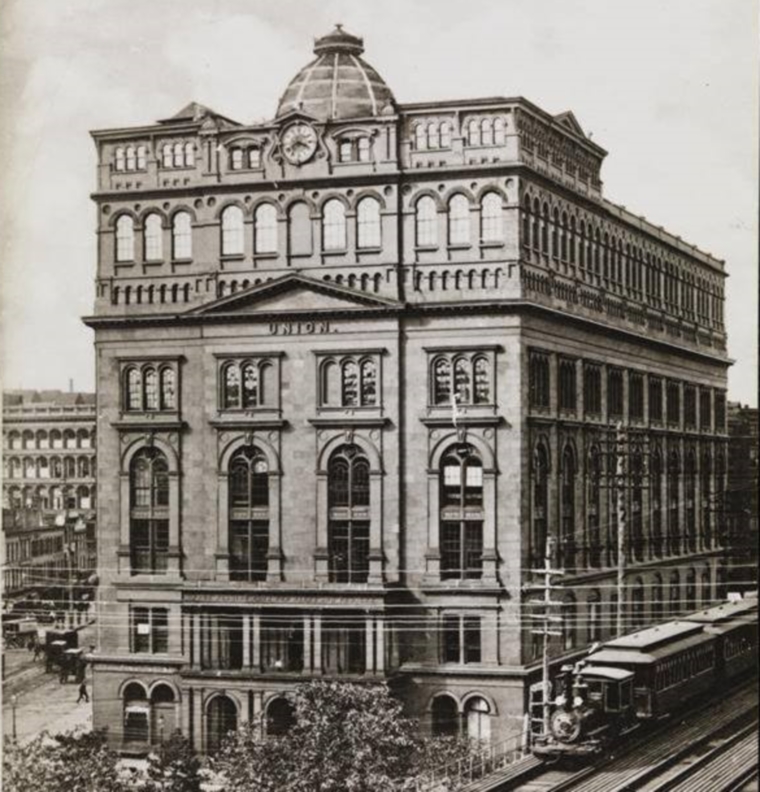
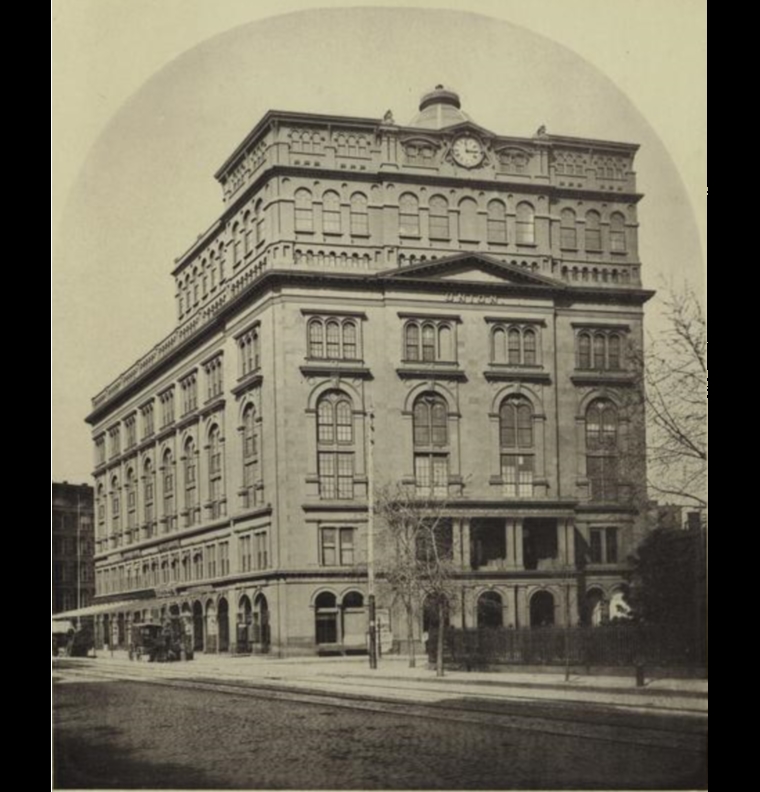
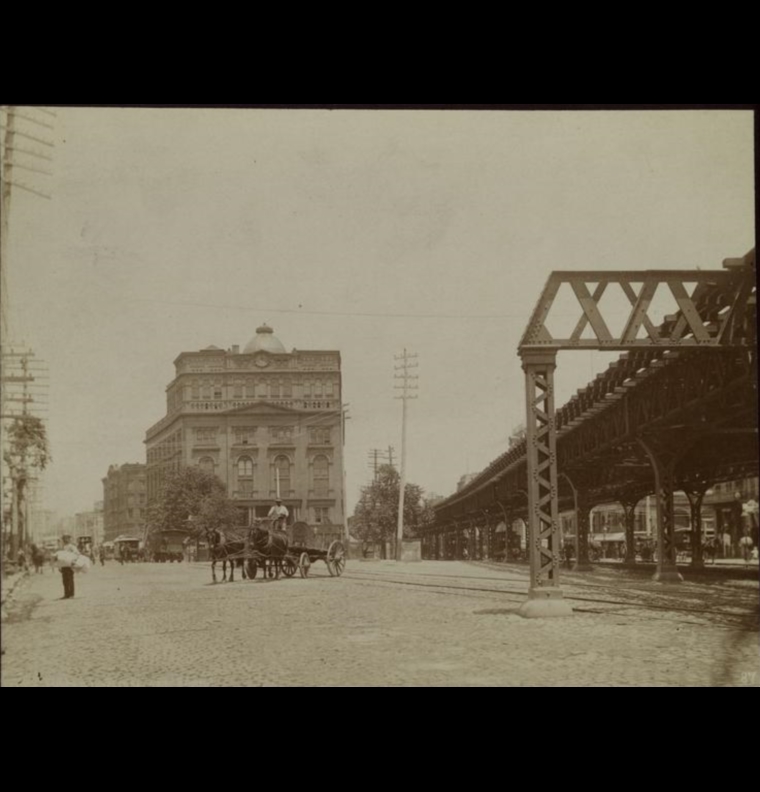
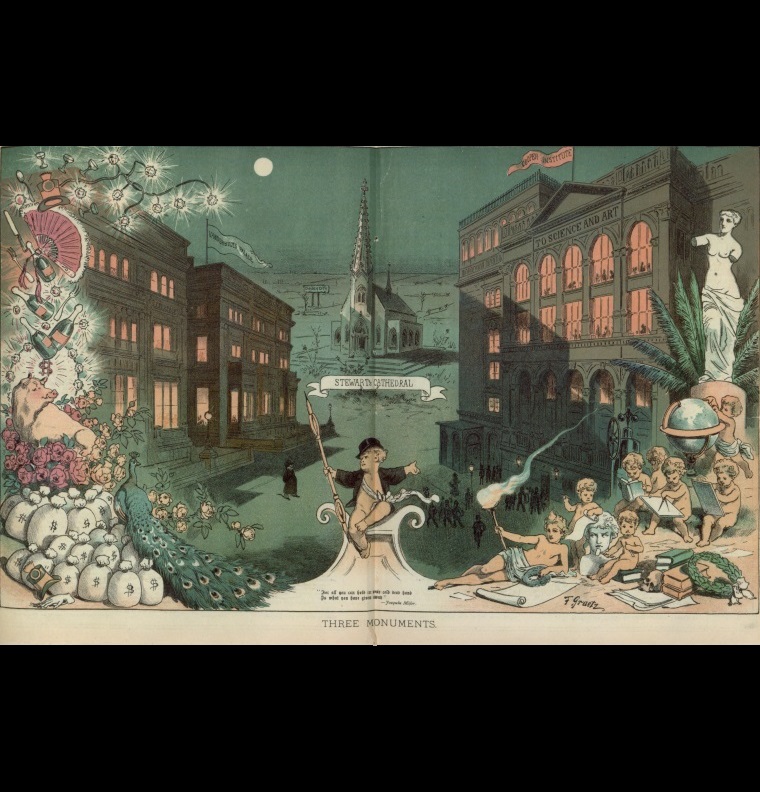
Finances during the Peter Cooper Presidency II
In AY 1880, Peter Cooper financed an addition to the building, two partial stories on the south side, called the Southeast and Southwest Pavilions, including a dome, a clock visible down the Bowery, and more room for the Free Art School for Women, including, according to Curator Zachos, an art gallery for the display of student drawings and paintings.
Messrs. Wilson G. Hunt, Daniel F. Tiemann, John E. Parsons, Edward Cooper and Abram S. Hewitt, trustees of the Cooper Union for the Advancement of Science and Art.
Gentlemen:
Please accept my check for $10,000, to be added to $10,000 of the Golden Wedding Fund, established by me seventeen years ago, the interest of which you have annually donated to institutions for aiding poor children. I also present my check for $30,000, together with the receipts in full for $70,000 I have expended during the last year on this building, hoping thereby, with your help, to enlarge the capacity of the institution for the purpose of giving free instruction to a large number of pupils in the application of science to all the useful and necessary purposes of life; to aid the trustees in arranging the the new part of the building, in accordance with their best judgment and efforts, for the accomplishment of the greatest possible good to the greatest number of the youth of this, my beloved native city; and to meet the expense of enlarging the course of instruction in this institution.
Very respectfully, your obedient servant,
PETER COOPER
The charts also show the expenditures of the Cooper Union. Expenses on the Free Saturday Lectures for the People dropped to zero between 1865 and 1873 as speakers were convinced to provide their services for free (and a thank you in the Annual Report). Despite funds not being received from the Pompton investment, in 1871, in fulfillment of the endowment gift, the purchase of books for the Library increased significantly and continued every year. Apparently, Susan N. Carter, when given permission in AY 1876 to reestablish the Amateur Class as a separate class in the afternoon, took the money directly and used it to pay the morning teachers directly, as the cash flow is never recorded in the latter Annual Reports. Peter Cooper set up a fund to reward employees with bonuses; the estate of Robert C. Goodhue provided money for a fund for the "Goodhue" prize, $30 in gold to a deserving female art student. Apparently in gratitude for the Cooper Union's participation in the 1876 Centennial, the Women's Centennial Committee used a surplus to appropriate $1,500 to the Women's Centennial Union Fund, to help indigent students in the Women's Art School pay for living expenses.
Academics during the Peter Cooper Presidency
|
AY 1860:
| AY 1864:
| AY 1883:
|
AY 1883 (continued)
|
Edward Cooper Presidency (1883-1904)
Selected Chronology during the Edward Cooper Presidency
- AY 1884: Typewriters purchased and first secretarial courses given
- AY 1884: A lunch room is established in the Woman's Art School
- AY 1896: After resigning due to ill health, Susan N. Carter dies "shortly after the close of the session"
- 1898, March 20: J. C. Zachos dies
- 1899, June 29: Daniel F. Tiemann dies
- AY 1892: Bachelor of Science degrees are awarded to all diploma recipients in the Free Night School of Science
- 1892, December 7: Wilson G. Hunt dies in the middle of the academic year
- AY 1893: Women are allowed to enroll in the Architectural and Perspective Drawing classes in the Free Night School of Art (at suggestion of the male Alumni of Art)
- AY 1893: Columbia University sponsors free Tuesday Night Lectures
- AY 1895: An instructor in Civics added to the faculty of the Free Night Schools of Science and Art
- AY 1895: Construction of the sixth floor is completed
- AY 1895: Board of Education sponsors the free Saturday Night Lectures
- AY 1897: Museum for the Arts of Decoration is opened to the public
- AY 1898: Columbia Professor Charles Sprague-Smith forms the People's Institute, giving free Thursday Night Lectures as well as Saturday Night Lectures in the Spring
- AY 1899: Board of Education adds Free Wednesday Night Lectures and the People's Institute changes from Tuesday to Monday and adds free Friday Night Lectures
- AY 1900: The People's Choral Union, conducted by Frank Damrosch, gives concerts in the Great Hall, but not for free
- AY 1901: First courses in Free Day School of Technical Science
- AY 1902: The People's Institute adds People's Symphony Concerts, conducted by Mr. F. X. Arens, but not for free (they become free by AY 1904)
- AY 1902: Courses in Naval Architecture started
- 1903, January 18: Abram S. Hewitt dies in the middle of the academic year
- 1905, January 15: Robert Swain Gifford dies in the middle of the academic year
- 1905, February 25: Edward R. Cooper dies in the middle of the academic year


Selected History during the Edward Cooper Presidency
The two decades after the founder's death were a time of change for the institution, with four of the remaining five trustees dying, as well as its curator and two of its influential directors of the Free Art School for Women. Those two decades also saw partnerships with the Board of Education, Columbia College, and the People's Institute, and the growth of an endowment from Peter Cooper's family and Andrew Carnegie's family, as well as others, that enabled the institution to build the Foundation Building up to its current height, clear out most of the lease holders on the various floors, create a new Museum for the Arts of Decoration, and, finally, open the Free Day School of Technical Science.
Academically, the institution expanded in various directions, with the establishment of the Free School in Stenography and Typewriting for Women, the free evening lectures expanding from one night per week to five nights per week, the introduction of a five-year civics requirement into the Free Night School of Science, the expansion of the three-year course in Chemistry into a five-year course, and the introduction of new two-year courses in Electricity and in Naval Architecture.The Free Night School of Art lets women into its courses in Architectural and Perspective Drawing. The Free Night School of Science had always let in women - on this webpage above is related the story of its first female graduate, in AY 1866 - but AY 1900 sees an astonishing accomplishment: Elizabeth Margaret Geiger graduates with a diploma from the Woman's Art School and a Bachelor of Science degree from the Night School. (The Alumni Association lists her as obtaining employment as a teacher in Scarsdale, NY. She also served at least two years as the Alumni Association's Treasurer.)
In AY 1892, Susan N. Carter relates this story:
A young colored woman came to the Cooper Union a few months ago. She was most ladylike and prepossessing in appearance. She brought with her a roll of drawings, on which she had been admitted to the Art School of the Corcoran Gallery in Washington. When she presented herself at that school, she was refused a place there, on the ground of her color solely. She showed me long letters from Frederick Douglas and others, protesting against such an injustice; but the decision against her was not changed. Knowing of the Cooper Institute, she came to New York to see about entering here. Recognizing the wrong done to her race in her exclusion from a school in the Capitol city of our country, twenty-seven years after our war was over, I felt that I was honoring New York City, as well as the dear memory of Mr. Cooper, if I let her at once have a place in my own office (as the class-rooms were full), till a vacancy should occur in the drawing-class room. This young colored girl is doing exceptionally well, and the kindness of her teacher and companions has helped to soothe her former grief.
Susan N. Carter starting teaching at Cooper in AY 1873; this isn't a tale of the Female Art School's first student of color, as CUHP knows of at least one Haitian student that predates this story. But it does speak to the racism of the times and of other educational institutions. Mrs. Carter follows up in the AY 1895 Annual Report:
It may be remembered that three years ago a colored woman from Washington, D.C., was admitted to the Woman's Art School. Mrs. Annie E. A. Walker is her name. Coming to the Cooper Union she was received here, where Mr. Peter Cooper's free gift of instruction makes no distinction of race or nationality. Mrs. Walker has been a very satisfactory scholar and now graduates. She has earned and saved more than $600 since she entered the Cooper Union, and will use this money for a year's study in Paris, after which she proposes to open a studio for portrait painting. The energy, ability and fine character of this colored woman are very encouraging, as showing the possibilities of her race.
The first lab fee is reported in AY 1894: ten dollars for "chemicals used" by chemistry students pursuing the special course in Qualitative and Quantitative Chemistry.
The full story of the alumni and their associations is related on the Alumni Organizations page, but it should be generally noted here that during these two decades the various alumni associations were formed and were given meeting space in the Foundation Building, that they were consulted by the Trustees and the faculty on various matters of importance, and that the first alumni financial contributions were received: on April 8, 1902, $1,000 from decorator Elmer E. Garnsey AR '74 and on May 26, 1902, $5,000 from civil engineer John F. O'Rourke '76, inventor of pneumatic caissons for skyscrapers.
Key Personnel during the Edward Cooper Presidency
- Trustees (AY 1884-1904): Edward Cooper, President; Wilson G. Hunt, Treasurer (AY 1884-1892); Abram S. Hewitt, Secretary (AY 1884-1902); Daniel F. Tiemann (AY 1884-1889); John E. Parsons, R. Fulton Cutting, Secretary (AY 1896-1904), Andrew Carnegie (AY 1901-1904), Peter Cooper Hewitt (AY 1903-1904)
- Treasurer: Edward R. Hewitt (non-trustee)
- Advisory Council of the School of Design for Women
- Full-Term (AY 1884-1904): Mrs. Wm. Tilden Blodgett, Mrs. Joseph H. Choate, Mrs. Abram S. Hewitt, Miss Eleanor G. Hewitt, Miss Sarah Cooper Hewitt, Miss Elizabeth Marbury, Mrs. Thomas M. Wheeler
- Early (AY 1884-1887): Mrs. Hamilton Fish, Mrs. E. H. Miller, Mrs. T. J. Oakley, Mrs. John Sherwood, Mrs. Richard Tighe
- From AY 1884: Mrs. S. L. M. Barlow (-1899), Mrs. V. Botta (-1890), Mrs. W. H. Osborne (-1892), Miss Georgiana Schuyler (-1892), Mrs. Edward Cooper (-1893), Miss Margaret A. Cooper (-1893), Mrs. Charles P. Daly (-1894), Mrs. Jonathan Sturges (-1894), Mrs. Burton N. Harrison (-1903)
- AY 1887-1904: Mrs. Lloyd S. Bryce, Mrs. J. O. Green, Mrs. F. B. Thurber
- Other: Mrs. Wm. S. Hoyt (1887-1891), Mrs. Richard Watson Gilder (AY 1888-1903), Mrs. Gaspar Griswold (AY 1892-1894), Miss Anna Roosevelt (AY 1892-1895), Miss Amy B. Hewitt (AY 1884), Miss Blodgett (AY 1895-1897), Miss Julia Cooper (AY 1896), Miss Mary A. Hearn (AY 1898-1902), Mrs. Albert Locke (AY 1898-1903)
- Until AY 1904: Mrs. Edward R. Hewitt (AY 1893-), Mrs. Henry Marquand (AY 1895-), Miss Constance Parsons (AY 1895-), Mrs. Charles W. Cooper (AY 1896-), Mrs. J. Woodward Haven (AY 1900-), Mrs. E. R. Wharton (AY 1900-), Miss Ethel Cram (AY 1901-), Mrs. Herbert Spencer Grimes (AY 1903-), Miss Kate La Montagne (AY 1903-), Miss Cornelia Bryce (AY 1904), Miss Elizabeth Cutting (AY 1904), Mrs. Lucius K. Gibbs (AY 1904)
- Directors, Museum for the Arts of Decoration (AY 1897-1904): Mrs. Abram S. Hewitt, Miss Sarah Cooper Hewitt, Mrs. J. O. Green, Miss Eleanor G. Hewitt
- Curator: J. C. Zachos (AY 1884-1897)
- Principal, Night School of Science and Art (and Day Schools of Science): George W. Plympton (AY 1884-1904)
- Director, Chemical Laboratory: Wm. Goold Levison (AY 1884), William Richardson (AY 1885-1899), Robert Spice (AY 1900-1904)
- Director, Physics Laboratory, William A. Anthony (AY 1899-1904)
- Principal, School of Design for Women: Susan N. Carter (AY 1884-1896), Miss Mary A. Vinton (AY 1897-1904)
- Art Director, Woman's Art School: R. Swain Gifford (AY 1897-1904)
- Directress, Free Day School of Telegraphy for Women: Mrs. M. E. Williams (AY 1884), Miss Annie F. Brown (AY 1885-1897), Mrs. A. F. Malone (AY 1898-1904)
- Director, Free School for Women in Wood Engraving: John P. Davis (AY 1884-1891)
- Teacher, Free School of Stenography and Typewriting for Women: Miss Frances E. Parrish (AY 1883-1888), Miss M. E. Robbins (AY 1889-1895); Miss Agnes Boldt (AY 1896), Miss Isabelle Kearney (AY 1896-1904)
- Acting Manager, Lecture Course: R. W. Raymond (AY 1884-1894)
Note: Mrs. Abram S. Hewitt is Sarah Amelia Cooper, PC's daughter and Edward Cooper's sister; Mrs. Lloyd S. Bryce is Edith Cooper, PC's granddaughter and Edward Cooper's daughter and only child; and Mrs. J. O. Greeen is Amelia Bowman Hewitt, PC's granddaughter, Edward Cooper's niece, and Abram S. Hewitt's oldest daughter.
Statistics during the Edward Cooper Presidency
| 1884- 1904 | Night | Day | |||||||
|---|---|---|---|---|---|---|---|---|---|
| Free Night School of Science (for Men and Women) | Free Night School of Art (for Men) |
Free Day School of Technical Science (for Men and Women) |
Free Art School for Women | Free School of Telegraphy for Women |
Free School in Stenography and Typewriting for Women |
||||
| Year | Diplomas | Medals | Chemistry | Graduates | Graduates | Diplomas | Graduates | Graduates | |
| AY 1884 | 11 | 8 | 1 | 30 | not opened | 20 | 47 | 42 | |
| AY 1885 | 9 | 5 | 0 | unknown | unknown | unknown | unknown | ||
| AY 1886 | 11 | 8 | 0 | ||||||
| AY 1887 | 11 | 11 | 0 | ||||||
| AY 1888 | 14 | 13 | 4 | 19 | 26 | 33 | 15 | ||
| AY 1889 | 24 | 20 | 2 | 46 | 39 | 19 | 25 | ||
| AY 1890 | 17 | 12 | 5 | 56 | 30 | 14 | 24 | ||
| AY 1891 | 21 | 15 | 0 | 57 | 31 | 20 | 18 | ||
| AY 1892 | 14 | 8 | 10 | 61 | 22 | closed for term | 22 | ||
| AY 1893 | 23 | 22 | 5 | 76 | 23 | 24 | 27 | ||
| AY 1894 | 18 | 2 | 65 | 29 | 17 | 24 | |||
| AY 1895 | 11 | 6 | 74 | 27 | 16 | 20 | |||
| AY 1896 | 24 | 9 | 47 | 26 | 18 | 21 | |||
| AY 1897 | 12 | 9 | 53 | 14 | 18 | 24 | |||
| AY 1898 | 22 | 7 | 58 | 17 | 16 | 25 | |||
| AY 1899 | 22 | 5 | 77 | 28 | 19 | 21 | |||
| AY 1900 | 23 | 9 | 63 | 10 | 15 | 29 | |||
| AY 1901 | 24 | 14 | 64 | no graduates yet | 16 | 14 | 25 | ||
| AY 1902 | 17 | 10 | 72 | 20 | names not listed | ||||
| AY 1903 | 46 | 27 | 47 | 1 | 12 | ||||
| AY 1904 | 38 | 17 | 61 | 5 | 21 | ||||
Methodology: In the Free Night School of Science, those receiving diplomas, medals, or listed as graduates are counted. In the Free Night School of Art, counting is more complicated: those receiving prizes and honorable mentions are counted; in AY 1902 "graduates" and "diplomas" are listed (in addition) and counted instead. In the Free Art School for Women, those listed as receiving diplomas are counted. In the Free School of Telegraphy and Free School in Stenography and Typewriting, those listed as receiving First Class Certificates are counted. In the Free Day School of Technical Science, those listed as graduates are counted.
Finances during the Edward Cooper Presidency
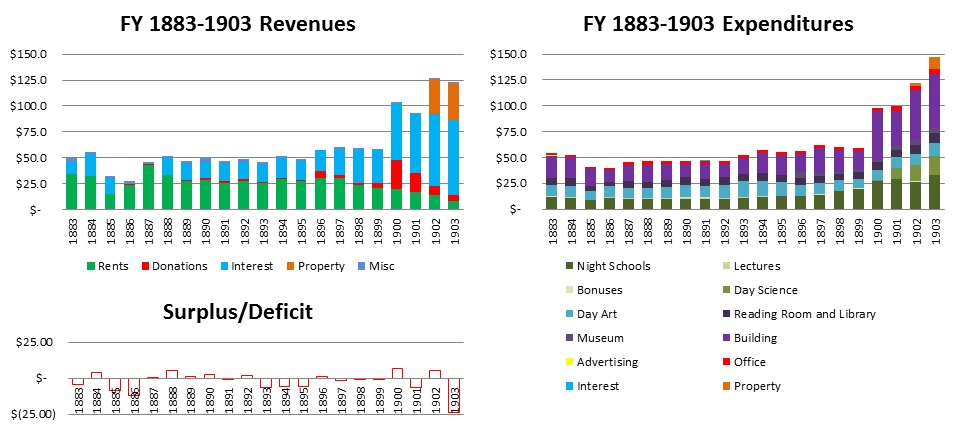
In FY 1894, the Cooper Union starts an endowment fund for "reconstruction of Building and Provision for the Woman's Art School." The bulk of the starting funds come from Edward Cooper, with large amounts from Abram and Sarah Hewitt, the William Cooper Foundation in Memory of Margaret Cooper, trustee John E. Parsons, and Henry G. Marquand, whose wife serves on the Advisory Council. Further money comes in FY 1895 from the William Cooper Foundation, this time in Memory of Henrietta and George C. Cooper. By FY 1896, with construction of the building completed, a permanent endowment of just under half a million dollars exists, invested in various railroad bonds and banks. Property is added in FY 1897, with the total value of investments at three quarters of a million dollars. Andrew Carnegie gives $300,000 to the permanent endowment fund in FY 1899, bringing its value close to a million dollars. Then comes FY 1901, in which Andrew Carnegie gives another $300,000, Edward Cooper and Abram S. Hewitt give $300,000, another $250,000 is provided by an "anonymous" donor, doubling the endowment to over two million dollars, allowing for the purchase of the "Lexington Avenue Property" (the Chrysler Building has not been built yet, but other buildings provide rent, with some investment). Although free lectures (and five symphony concerts) are being given five nights a week, there is some remaining rental income from the Great Hall on the other two nights.
With Abram S. Hewitt's death at the beginning of FY 1903, an Abram S. Hewitt Memorial Endowment, starting with over $200,000, is established by the Mayor of the City of New York, with $55,000 coming from Andrew Carnegie, $50,000 coming from John D. Rockefeller, and $25,000 each coming from J. P. Morgan and W. E. Dodge. An additional initial $175,000 of proceeds from the estate of John Halstead, left after the death of a life-tenant (Mrs. Hannah C. Wibert) on December 21, 1902, and primarily consisting of coal lands in West Virginia, brings the size of the endowment up to two and a half million dollars (this bequest is later valued at $366,000 in FY 1904).
Academics during the Edward Cooper Presidency
AY 1884:
|
AY 1884 (continued)
|
AY 1904:
| AY 1904 (continued)
|
AY 1904 (continued)
|

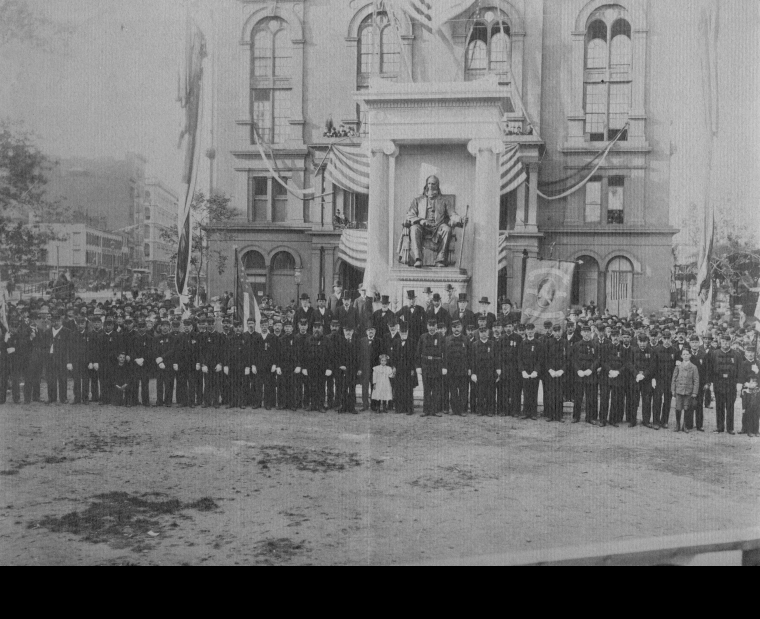
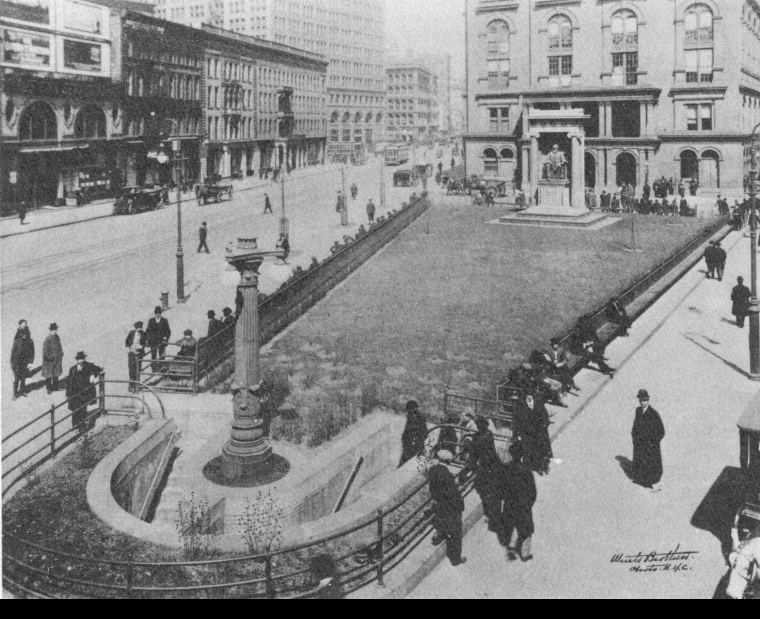
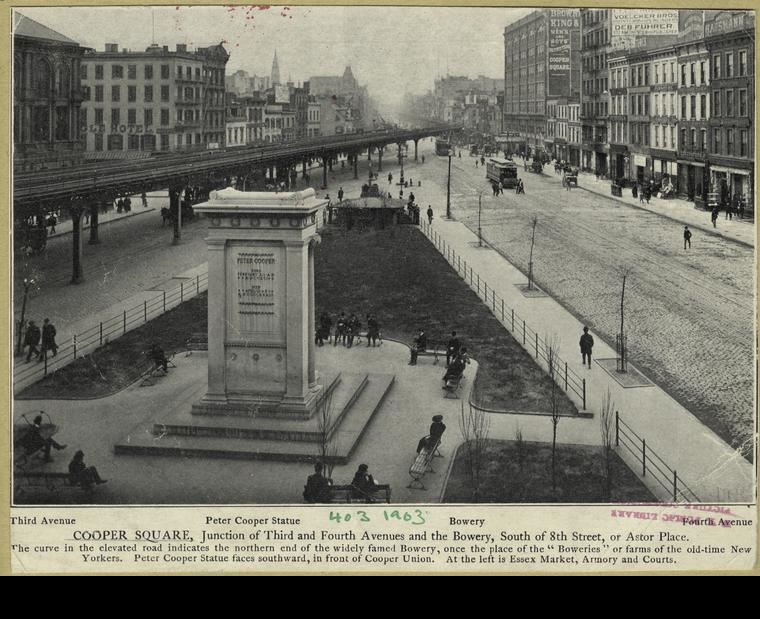
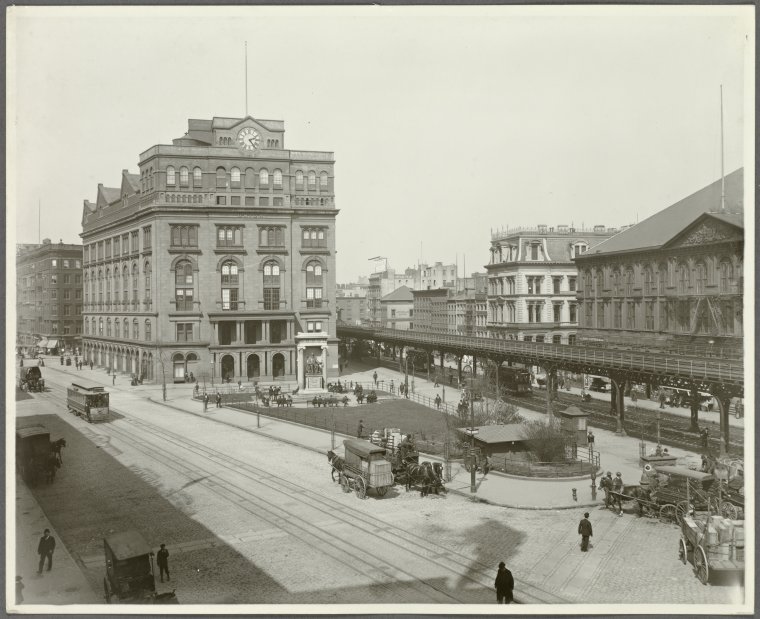
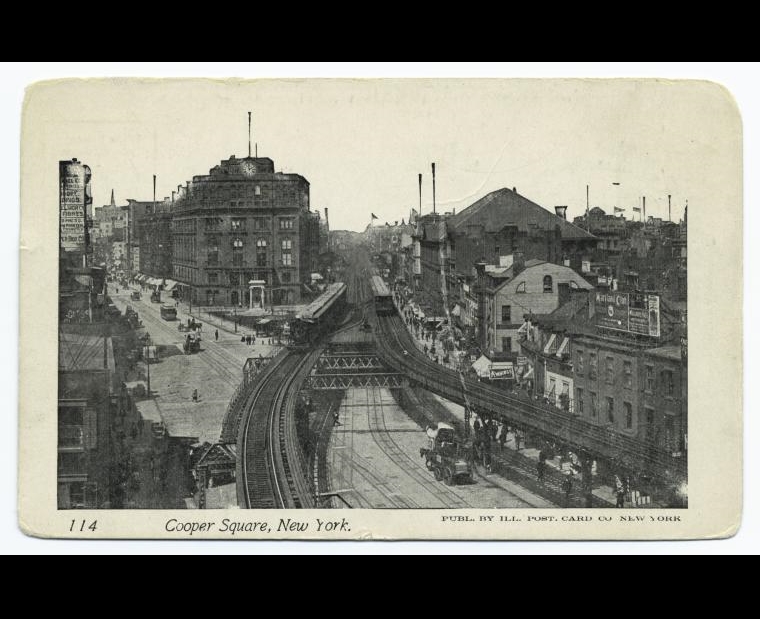
John E. Parsons Presidency (1905-1915)
Selected Chronology during the John E. Parsons Presidency
Selected History during the John E. Parsons Presidency
[Around 1907], Miss Sally Hewitt and Mrs. Montgomery Hare opened a shop to serve as a clearing house for the work of the Union's art students. It was known as Au Panier Fleuri, and sold furniture, screens, wall panels, lampshades, wastebaskers, and other decorative products of students with great success. In 1921, by which time many other outlets for this type of work existed, it was sold for around $17,500 to a former Cooper Union student, Mrs. Harry Kreuter. Financially independent of the Union, it is staffed by former Cooper Union students and sells only the work of Cooper Union graduates. The proceeds of the shops' sale to Mrs. Kreuter were added to the Union's general endowment fund and the income from this is annually included in the museum's budget, including contributions from a group known as the Friends of the Cooper Union Museum for the Arts of Decoration.The New Yorker, Spiritual Refuge, August 21, 1937
Key Personnel during the John E. Parsons Presidency
- Trustees: John E. Parsons, President; R. Fulton Cutting, Secretary, Andrew Carnegie, Peter Cooper Hewitt
- Treasurer: Edward R. Hewitt (non-trustee)
- Advisory Council of the Woman's Art School, School of Stenography and Typewriting, and School of Telegraphy: Mrs. Abram S. Hewitt, President; Miss Sarah Cooper Hewitt, Chairman; Mrs. J. O. Green, Secretary; Miss Kate LaMontagne, Treasurer
- Executive Committee of the Woman's Art Club Members: Mrs. Charles B. Alexander, Mrs. Lloyd S. Bryce, Miss Clare Bryce, Miss Cornelia Bryce, Mrs. Joseph H. Choate, Mrs. Charles W. Cooper, Miss Julia Cooper, Miss Ethel Cram, Miss Elizabeth Cutting, Mrs. Lucius K. Gibbs, Mrs. J. O. Green, Mrs. Herbert Spencer Grimes, Mrs. J. Woodward Haven, Mrs. Abram S. Hewitt, Miss Sarah Cooper Hewitt, Miss Eleanor G. Hewitt, Mrs. Edward R. Hewitt, Mrs. Peter Cooper Hewitt, Miss Kate LaMontagne, Miss Elizabeth Marbury, Mrs. Henry Marquand, Mrs. John E. Parsons, Miss Constance Parsons, Mrs. F. B. Thurber, Mrs. E. R. Wharton, Mrs. Thomas M. Wheeler; Ex-Officio: Miss Elizabeth Cutting
- Directors, Museum for the Arts of Decoration: Mrs. Abram S. Hewitt, Miss Sarah Cooper Hewitt, Mrs. J. O. Green, Miss Eleanor G. Hewitt
- Principal, Scientific Department: George W. Plympton
- Director, Chemical Laboratory: Robert Spice
- Director, Physics Laboratory: William A. Anthony
- Art Director: Frederick Dielman
- Principal, Woman's Art School: Miss Kate L. Reynolds
- Instructor, Free Day School of Telegraphy for Women: Mrs. A. F. Malone
- Instructor, Free School of Stenography and Typewriting for Women: Miss Isabelle Kearney
Finances during the John E. Parsons Presidency
|
|
Academics during the John E. Parsons Presidency
AY 1905:
| AY 1905 (continued)
|
AY 1905 (continued)
|
AY 1905 (continued)
|
Historical Inaccuracies
The Amateurs
Although Iyer had established that there were no amateurs paying for classes at the Cooper Union after AY 1898, the President of the college repeatedly told the media that "prior to 1902" some students were charged. Student protesters actually printed balloons in 2012 with "110 YEARS FREE" printed on them. Local news cable channel NY1 and local radio station WNYC repeated the misinformation. When WNYC printed a correction, Professor Peter Buckley posted to their comment section:
As the historian at Cooper Union I'd like to make a correction to WNYC's correction above. With the exception of a small number of amateur students in the women's Day School of Art all students in certificate or degree programs have received tuition without paying for it. This has been the case since 1859. The "110" year statement refers to students in the Day School of Engineering, but since it only opened in 1901 it would be hard for the institution to charge tuition for that school before its founding! Let's not pretend it was the policy of Cooper Union to charge tuition in its early years and that mere circumstance has delayed its return.
First, there were three years of transition. In the 1858-1859 academic year, before the school was officially advertised and opened, the pre-existing female School of Design moved into the Foundation Building - there is no Annual Report and no record of the ratio of free to paying students. In AY 1860 academic year, the School of Design formally became a part of the Cooper Union, and the trustees wrote a by-law to allow for the existence of "industrial" students vs. "amateur" students, as follows (italics in the original):
The Trustees shall establish and maintain a school for the instruction of respectable females in the art of design, and in such other branches of knowledge as in their judgment will tend to the elevation and employment of female labor. The instruction afforded in this school shall be given without charge, but the regulations may provide for the admission of amateur pupils for pay, so long as industrial pupils are not thereby excluded. All money received from such amateur pupils shall be applied to the support of the school. The industrial pupils will be required to aid in the instruction of the school, so far as the director thereof may require.
That year the amateur students were limited to one tenth, or 12 out of 120. In AY 1861, regulations were written about the requirements for each type of student, and the numbers were increased to 200 industrial students and 100 amateur students, but the amateurs were only interested in the more artistic offerings, and only attended for half-a-day (the morning).
In AY 1864, the waters were muddied by this statement in the Annual Report:
THIS School has been established and is maintained by the Trustees with the primary object of affording free instruction in the Arts of Design to Females, who, having the requisite natural taste and capacity, intend to apply the knowledge acquired in the Institution to their own support, either by teaching or by pursuing art as a profession. It is not, therefore, designed for the rich, but as it is an advantage to the School, both in point of income and refinement, that pupils who are able to pay should be admitted, the Trustees have decided to admit amateurs to the extent of one-third of the whole number of pupils. But, in order that people in moderate circumstances may avail themselves of the great advantages of the School, the rates have been made extremely moderate — viz., one dollar and fifty cents per week for instruction in Drawing, and two dollars per week for instruction in Pastel, Water-Color, or Oil Painting. Pupils will not be received for less than ten weeks, and the fees must be paid in advance. As many pupils have heretofore been admitted as free pupils whose means amply justified the small payment required from the amateurs, the Trustees are constrained to ask such pupils to remember that each paying pupil secures the admission of two free pupils, and that the usefulness of the School will be greatly extended if all who can and ought to contribute to its support perform their duty. Any pupil who can afford to pay and does not do so actually deprives three poor and deserving girls of admission to the School, and the opportunity to earn an honest livelihood in a respectable and useful sphere of life.
Unfortunately, although the reports were written at the end of the academic year, finances were calculated as January to December. Tracking the receipts of the School of Design, the amount charged and number of students paying peaks in AY 1864 but, using the financial charges above, never rises above 100 students. The sudden drop to half in FY 1867 points to an admission policy change at the beginning of AY 1868; this is followed by a drop to a tenth of that half in FY 1868 - perhaps one or two amateur students were allowed in or were simply late in their payments, as the Annual Report for AY 1868 makes the policy change explicit, in a section about the School of Art for Women: "The instruction is absolutely gratuitous, and no paying pupils have been or will hereafter be received." From there forward, letting amateurs into the industrial classes had stopped completely, as receipts from the School of Design are no longer reported. Barry Drogin has suggested that these "amateurs" might be better understood as "auditors," in modern parlance.
In her fourth year as principal of the female art school, in AY 1876, Susan Carter persuaded the trustees to revive the notion of the amateur class, but this time as a separate afternoon class just for amateurs. She reports on 59 amateur pupils admitted to taking a drawing class, out of 343 students total (including 37 public school teachers taking a new "Normal Teachers" class on Saturdays, the first "Saturday Program"). In AY 1890, she proposed adding a morning amateur class, but Hewitt refused. The afternoon classes, for amateurs only, persisted until AY 1898.
The Meritocracy
By AY 1866, the trustees realized that this policy was causing problems and stated that "selection and discrimination will henceforth be made." However this policy was implemented, it was merely used to remove applicants who, through lack of schooling, did not possess the mathematics to handle the courses offered. The trustees also separated the new students into two groups so that "the more advanced may not be retarded." As late as AY 1882, according to J. C. Zachos' "Curator's Report" in the Annual Report:
These pupils are admitted on the simple rule of “first come first served,” with such qualifications as are required by a good character, a suitable age, and an expressed purpose to turn the advantages of the Institution to industrial purposes and self-support; — otherwise the classes would soon be filled with “amateurs” in art, and in the studies of science.
The problem of competence surfaces again in the AY 1898 Annual Report:
In order to bring the number within reasonable limits, it was decided to raise the standard of admission by requiring a knowledge of the elementary principles of algebra for admission to the full course of the institution. This step was taken upon the recommendation of the Committee of the Alumni, based upon the fact that the elements of algebra are now taught in the public night schools, and therefore it was a waste of effort on the part of the Cooper Union to provide instruction which could be got elsewhere without charge. The total number of applicants for the lowest class of the Scientific Department was 924. Of this number only 320 became members of the school. The notices sent to applicants in September bore the reminder that some slight knowledge of algebra was necessary to gain admission. Many who were notified failed to respond. It required a call upon 725 applicants to bring in 320 pupils. Of this number 46 proved to be deficient in the requirement. They were, however, admitted and formed a preparatory class, studying algebra only. It would seem that about 400 of the applicants were unprepared to meet the new condition. Still, the class was filled, with almost 200 left unnotified. It is probable that many, if not most, of the disappointed applicants obtained admission to the Evening High Schools, where the opportunities for learning algebra and geometry are ample.Report of the Director of the Free Night Classes in Science and Art
Last year it was found necessary to make some changes in the method of determining more accurately the relative proficiency of the pupils, in order that they should be able to advance according to their ability, or that their places could be filled by those more talented from the waiting list. This plan has been constantly carried out, and already the benefit from the change has been decidedly felt.
And the standards are raised again in AY 1890:
Every department of the institution is filled to repletion, and the waiting lists for the Woman's Art School and for the night classes have not been materially reduced, although the standard of admission to the latter has been raised. By the report of the Director of the Night Classes and of the Committee of Alumni, it will be seen that a further advance in the standard of admission is recommended so as to include a better knowledge of algebra and familiarity with the first book of Euclid. It is believed that at least one year in the course of instruction can thus be saved, which will enable the enlargement of the courses of instruction in directions made necessary by the extraordinary progress in the industrial arts, and particularly in the application of electricity to many new departments of business. The Trustees have authorized this advance in the standard of admission to be put in operation, because the preparatory knowledge required can now be gained in the higher night schools carried on by the Board of Education, with whom the officers of this institution are in cordial relations.
These policies persisted into the 20th century. The AY 1902 Annual Report mentions replacing incompetent art students with others refused entry previously:
The process of exclusion of incompetent pupils, after a trial of about three months, has been continued and new pupils admitted from the mailing list.
It wasn't until 1921 that the faculty introduced an intelligence test for students. The expansion of this into what is now referred to as "the meritocracy" is covered in subsequent sections of this website.
Rich vs. Poor
These classes are designed especially for the improvement of mechanics and mechanics' apprentices; but, as the arrangements are adequate for at least 800 pupils in each branch, no applicants will be rejected, unless the rooms are crowded, in which cases the preference will be given to the working classes.
The policy evolved. In the AY 1874 Annual Report, J.C. Zachos states:
[T]his Institution offers its advantages to the rich as well as the poor, to those independent of paid employment, as to those who are so dependent. The Cooper Union cannot be regarded merely as an eleemosynary institution, but as illustrating a great idea — the union of Art and Science with each other, and with practical life — the union of productive labor, with the refinements, the training and the education that make human life, worthy and happy.
In the AY 1875 Annual Report, Susan Carter makes the following statement:
In our present pressure of scholars, we have been obliged to make the rule constantly more stringent in regard to not accepting persons able to pay for their tuition. But we have had a large number of applicants who express willingness to give money for a teacher, if they may only be allowed the privileges of the school, casts, rooms, &c. In view of this fact, I have been allowed by the Secretary, subject to the approval of the Trustees, to form such a class in the afternoons, to be under the care of an instructor, approved by the Institute. The pay received from this class to be divided between the teacher and the Free School; and the money belonging to the Free School to be applied to teaching painting on porcelain and ornamental oil painting for furniture, &c.
The policy is next stated in the AY 1880 Annual Report:
[N]o personal interest or favor is shown in the admission of pupils; except some special need for purposes of self-support and precedence in the application.
Historically, we know that Thomas Edison - at a time when he was quite wealthy - attended a Cooper Union class (although he did not sit for examination or seek to earn a certificate). It is well to realize that, from the beginning, the night classes were explicitly scheduled as night classes so that students could hold jobs during the day, and a long list of the occupations of the entering class is including in the very first Annual Report and repeated until the AY 1875 Annual Report.
Art, Engineering, or Political Science?
As to political science, the Deed of Trust is explicit:
the course of instruction on social and political science, hereinafter provided for, shall have the preference over all the other objects of expenditure specified herein, in case there shall not be means adequate for them all, and shall forever stand pre-eminent among them.
Yet, at its opening, the course was not established, as stated in the AY 1861 Annual Report:
The class in Political and Social Science was not organized in consequence of the difficulty in procuring a suitable instructor.
The problem is finally resolved in the AY 1864 Annual Report:
The course of instruction on Social and Political Science called for by the trust deed, was during the year 1863 carried on by a series of twenty-one public lectures, delivered in the great hall.
According to the AY 1869 Annual Report, the free lectures in the Great Hall were also supplemented by a course:
The Trustees take this occasion to acknowledge their indebtedness to the gentlemen who tendered their gratuitous services as lecturers, and especially to Mr. RICHARD LEVISON, ESQ., who conducted a class in Social and Political Science, during the winter, meeting twice a week, and declined all compensation for his laborious and highly successful efforts. This class was very interesting, as the first attempt to teach Social and Political Science in a systematic manner, under the express provision of the Trust Deed, and the results were such as to encourage the Trustees to make more full and complete provision for such instruction in the future. Forty pupils entered the class, of whom fifteen were examined at the close, and gave evidence of great progress.
These eventually were referred to as the "Free Saturday Night Lectures For The People."
As to engineering, there is no doubt of Peter Cooper's desires, dating back to his first idea for the institution, upon learning of the Ecole Polytechnique of Paris in 1830 or 1831. What can be confusing is that the Charter and Deed refer to three different entities: "regular courses of instructions, at night, ... on the application of science to the useful occupations of life," "galleries ... of scientific collections," and "a thorough polytechnic school." The AY 1900 Annual Report provides the solution:
The fourth provision looks to the establishment and maintenance of a polytechnic school by day, so that the space used at night might also be employed in the daytime for the purpose of technological education...The problem thus presented to the Trustees was to determine how far the means at their command would justify them in undertaking a new and independent department of technical instruction by day. [T]he idea of the Trustees was that a Mechanics Arts high school should be established on the general lines which had been projected by the Board of Education of the City of New York for the boys who had completed their course in the public schools...Now the design of the founder of the Cooper Union was not to teach trades, but to give instruction to those already engaged in trades in such departments of knowledge as might fit them to become foremen, employers and good citizens...The Trustees were therefore compelled to abandon the idea of the Mechanics Arts high school on the lines which had been suggested to them, but out of the consideration given to the subject, the proper solution was readily found. The Cooper Union was designed for workmen and the night classes supplied these workmen with the knowledge which they desired to get...
When the three laboratories are established and have reached their full development, all the stores upon the first floor of the building will be required for the art classes or for the extension of the Physical Laboratory...When these extensions have been made, a very much larger number of pupils will be accommodated at night, and the whole of the space occupied by them will be available by day for the young men and young women who may be able to give the time necessary for work in the several laboratories above described. By these arrangements it will be seen that the night classes have practically been projected into the daytime, and that all the provisions made for them will be available for another set of students who may require instruction either in the Chemical, Physical or Art Laboratories, and who are able to give the time necessary for such work during the day. Naturally these students will be drawn from a different class from those who are engaged in earning their living by day. There are many persons in the City of New York who can so arrange their occupations, or who have sufficient means saved out of their earnings, which will permit them to perfect themselves in some of the branches, which henceforth will be taught by day under extremely favorable conditions for their use. The Cooper Union was designed by its founder to be entirely free of all charges for instruction, and hence these new departments carried on by day will open opportunities to many persons who may be able to provide themselves with food and clothing, but who could not afford to pay for instruction.
In this way, the Free Night Schools of Science were simultaneously the "thorough polytechnic school" which then became "projected" into the Free Day Schools of Science. In the AY 1901 Annual Report, there are expenditures "For Free Night Classes in Science and Art" and "For Free Day Classes in Science and Art" (separate from "For Free Art School for Women"), with 29 students admitted into day classes in the Chemical Laboratory and another 29 students admitted into day classes in the Physical Department. In the AY 1902 Annual Report, instructors are listed for the "Night Schools of Science and Art" and the "Day Schools of Science," although the instructors in the latter are merely a subset of the instructors of the former.
As to art, Peter's announcement to the Times in 1852 of his plans included renting five rooms on the fifth floor to artists. The initial architectural plans included a museum on the third floor. And then, in 1858, he allowed the Women's School of Design to occupy the Foundation Building for free, prior to the final versions of the Charter and Deed of Trust, which incorporated the Women's School into the Cooper Union.
In the first Annual Report (AY 1860), the trustees established two principles:
First, that the details of the Institution in all the departments should be arranged with especial reference to the intellectual wants and improvement of the working classes. And, second, that as far as might be consistent with the first principle, all interference with the plans or objects of other existing institutions in this city should be avoided.
The Cooper Union was predated by the National Academy of Design, established in 1825 and given its first permanent home at 23rd Street and Fourth Avenue between 1865 and 1899. Throughout its early years, the Cooper Union positioned itself between existing institutions. The Women's School of Design, then, was for initial training of females with some aptitude in art. Some students were trained to become teachers, others to earn a living in coloring lithographs or engraving. Particularly talented art students graduated and went on to the Academy. Similarly, the purpose of the Male School of Design was described in this newspaper article quoted by Lester:
The male classes in the art schools are for the most part made up of apprentices in architects’ offices, and of designers of tiles, wall papers, oilcloths, carriage painters and makers, mechanical sculptors, and of kindred trades where artistic workmanship is called for. There is no other school in New York where facilities of this sort are furnished free. The Society of Mechanics and Tradesmen gives free lectures to artisans on certain branches occasionally, but they do not pretend to the scope and thoroughness of the Cooper Union courses. The largest classes in the art department are in free-hand drawing, and in mechanical, architectural and industrial drawing. All the lessons are practical, and bearing on the employments in which the arts of design and drawing arc principal or accessory occupations. But if the pupil shows a talent for high art, and has the leisure and means to pursue it, he is recommended to other schools in this city established for the special instruction of professional artists.
The female art school maintained close relations with the Academy, with some teachers teaching in both schools and some Academy teachers giving guest lectures at Cooper. By AY 1876 the female art school was actually teaching art teachers from other schools, and it continued to grow in quality and prestige, both in faculty and students.
Similarly, the School of Science considered itself situated between the trade schools and the prestigous engineering school of Columbia University. In AY 1892, alumni approached the trustees with a request to add the grade of Bachelor of Science to the medals intended for those who had completed the entire course of instruction and passed satisfactory final exams. The trustees agreed, and even agreed to retroactively provide Bachelor of Science degrees to alumni. They would also provide degrees of Civil Engineer and Mechanical Engineer to "post-graduates" (alumni) examined and certified by a faculty committee. The first degree of Civil Engineer was awarded to a member of the Class of 1876, and the first degree of Mechanical Engineer was awarded to a member of the Class of 1870. In AY 1899, the faculty awarded the first degree of Electrical Engineer to a member of the Class of 1895. In AY 1900, the trustees stated:
The intention is to maintain a free school primarily for the education of workmen, and not a professional institution for the education of engineers, although it is to be expected that in the future, as in the past, its graduates will by their training and ability be fitted for the most responsible and difficult positions in practical business...The Cooper Union schools and laboratories will thus be made to supplement, but not to replace, the courses of instruction furnished in the High Schools, and thus become the means of admission to the higher courses of instruction now offered by the scientific and engineering departments of Columbia University for all students who may possess the ability to reach the highest grades of scientific education...The course of instruction in the High Schools, in the Cooper Union schools, and in the University, will thus become a continuous scheme of scientific and practical education, and the day schools of the Cooper Union will thus fulfil the design of the Founder, when he made provision for the establishment of a school of Technology.
The Annual Report makes clear that these "post-graduate degrees" were equivalent to Professional Engineering licenses, and would only be conferred upon graduates after a "suitable period (from three to five years) of engineering practice." Although required courses in chemistry date to the founding of the Union in 1859, and in 1881 the trustees approved a proposal for the Chemistry Laboratory to develop a three year course of study, it wasn't until AY 1922 that a committee was formed to confer post-graduate degrees in Chemical Engineering, and in AY 1924 the course of Industrial Chemistry (first established in AY 1870) in the Day Technical School, renamed the Institute of Technology, was developed into a course in Chemical Engineering.
Sources:
Links to on-line sources and listings of other sources can be found on the homepage.
Abbreviations:
CY = Calendar Year; AY = Academic Year = July of CY-1 through June of CY; FY = Fiscal Year = CY (AY 1908 and before) = AY (AY 1917 and later)The Cooper Union History Project website is currently maintained by Barry Drogin. This page last updated: May 13, 2020.